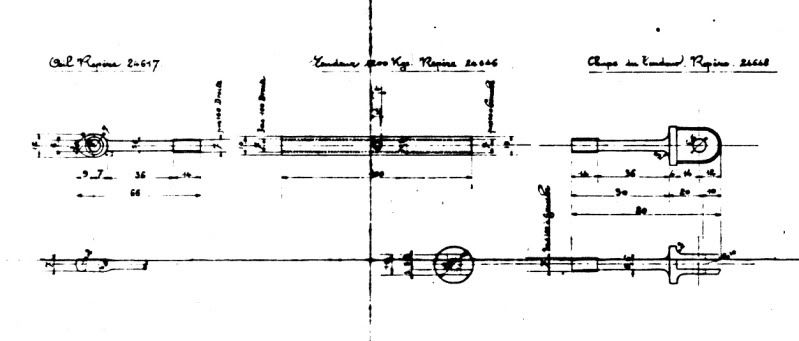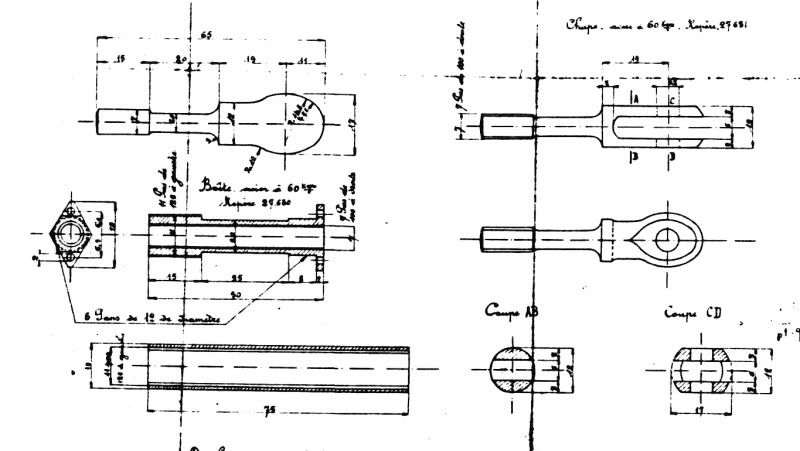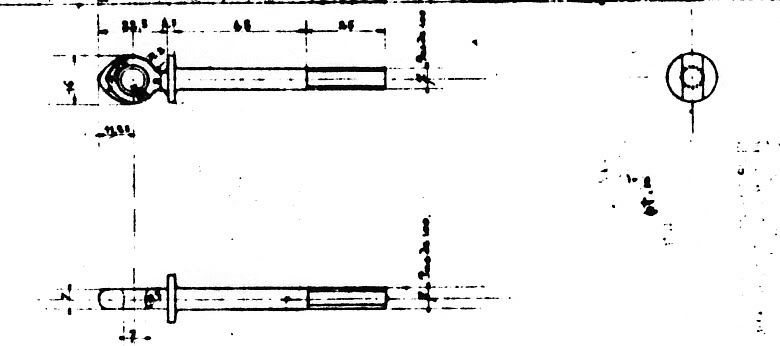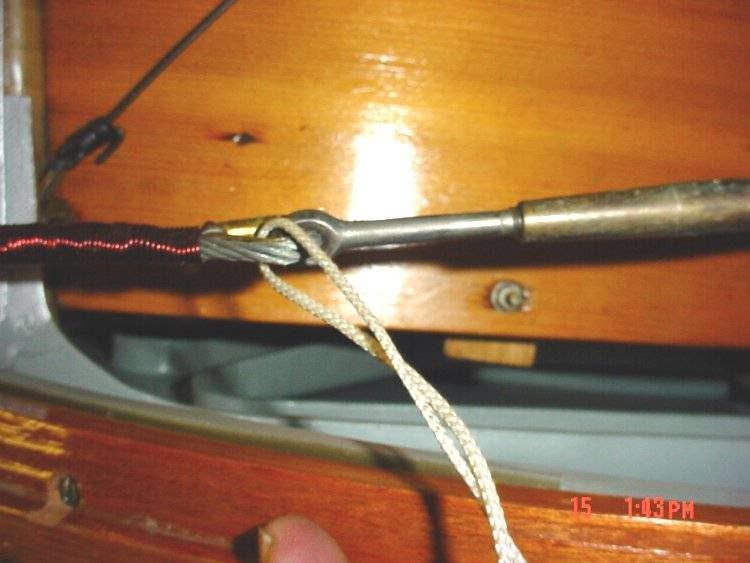 Thanks: 0
Thanks: 0
 Likes: 0
Likes: 0
 Needs Pictures: 0
Needs Pictures: 0
 Picture(s) thanks: 0
Picture(s) thanks: 0
Results 16 to 30 of 33
-
8th May 2009, 02:01 AM #16

I'm an engineer, too, so I might want to dispute the notion that we "know" what we're doing. (Only half-kidding, of course). I've found that the more I learn, the less I know; because upon each learning, I also become aware of the expanded knowledge unreachable in the crush of time.
The easiest way I've found to post pictures of CAD images, is to print the image and photograph the print. I generally shy away from rendering, because for my purposes it isn't necessary. Here's an example: http://www.woodworkforums.ubeaut.com...ad.php?t=47976
Do you also have pictures of the originals? Preferably to illustrate the variations in end styles. Aside from left/right-hand threads, I'm aware of only a few end styles commonly needed, e.g. eye, shackle, hook; these are usually driven by attachment functions for construction or maintenance.
Thank Goodness you and the other participants know more than I do. I'll try to email a link to this thread to an intermittent neighbour. He may, or may not, wish to follow it or participate. He wrote the book on helicopter rescue - really, he actually wrote the book; and now is a consultant to NASA.
Cheers,
JoeOf course truth is stranger than fiction.
Fiction has to make sense. - Mark Twain
-
8th May 2009 02:01 AM # ADSGoogle Adsense Advertisement
- Join Date
- Always
- Location
- Advertising world
- Age
- 2010
- Posts
- Many
-
8th May 2009, 11:56 AM #17

Here is an Australian mob that might have what you want.
And here are some piccies of there wares.
http://www.ronstan.com/catalogue/A_P19-23.pdf
http://www.innovativerigging.com.au/...gScrewData.pdf
Australia - VIC
Ronstan International Pty Ltd
220 Bay Road
Sandringham, VIC, 3191
+61 3 8599 0000
T+61 3 8599 0099
F[email protected]
Australia - NSW
Ronstan International Pty Ltd
Unit 67
42-46 Wattle Road
Brookvale NSW 2100
+61 1300 13 15 20
T+61 2 8968 5099
F[email protected]
E
-
8th May 2009, 07:32 PM #18

im a machinist so dont know a huge amount of the engineering math and stuff or the paper work needed for planes but if you can why not make them yourself? 60-100 parts wouldn't really take to much time as for CNC's it would cost to much the first order is always the most expencive (and takes the most time) so it wouldnt be worth it if you only need X amount
what does the part look like?
take a look at this site http://thevintageaviator.co.nz/happy turning
Patrick
-
8th May 2009, 10:04 PM #19

I have some pics but the French apparently like to wrap the turn buckles in string! So not much detail there but I do have the original engineering drawings. These show various fittings that need to be manufactured. They are very poor copies (but I paid good money for them
 ). A few guys in US/Canada are working to get me a good set of drawings but it's a slow process to scan them (about 300+ dwgs all up).
). A few guys in US/Canada are working to get me a good set of drawings but it's a slow process to scan them (about 300+ dwgs all up).
I have had a family induced pause in my CAD activities this weekend! Will get back to it when I can. Might see if a scan of the original drawings works too.
Happy to involve anyone who wants to join in the discussion!
Fossil: Thanks for the links. We have their catalogues at work for rigging antennas, etc. I have had a look at them but they are a little too big and far too heavy. I am very weight conscious as many amateur builders over do their work and end up with a dog of an aircraft to fly.
new_guy90: The main reason I can't make them is that I don't have the equipment. I have a rough idea of what I need from advice from other builders but I can't afford to set up shop. I used to manage heavy engineering workshops with fantastic equipment so never bought anything myself (didn't even own a spanner set!). I'm buying a few woodworking machines but don't have thousands for a lathe and mill. I'm trickle feeding my project - won't have lump sums unfortunately.
Thanks for all the interest and suggestions!
-
8th May 2009, 10:38 PM #20
 China
China











- Join Date
- Dec 2005
- Location
- South Australia
- Posts
- 4,475

brinesharks, Another option, see if you can find a local metal working hobbiest who may be able to make what you need at a reasonable cost
-
8th May 2009, 10:49 PM #21

I finally bit the bullet, and Googled [Nieuport 17] to see what we're talkin' about. Basically a bi-plane. The subject of turnbuckles may be buried too deep.
I'll hazard a guess, that the string wrap, especially about the bodies, is to reduce wind-induced flutter, so that they behave more like solid cylinders, with better-defined shape factors. The end fittings might also benefit from this attention, depending on the types. IIRC, some sailboat hardware turnbuckles have solid bodies (for the same reason), but of course "boat"-anything = $$$.
It all might be over-kill, but it might not, too. Aerodynamics is not my strong suit. But we encounter similar problems in cable-stayed and suspension bridges under lateral wind load. "Solutions" are generally hit or miss.
Fatigue is the mortal enemy of aircraft. The first Comets had sharp-cornered windows, copied from the DC-3. 'Twas not the perfect answer. Now, aeroplane windows have rounded corners.
Cheers,
JoeOf course truth is stranger than fiction.
Fiction has to make sense. - Mark Twain
-
8th May 2009, 11:44 PM #22
-
9th May 2009, 02:45 AM #23
 Senior Member
Senior Member











- Join Date
- Oct 2008
- Location
- Cairns, Q
- Posts
- 351

Hi Joe,
Typical construction of a WW1 aircraft fuselage was to have four wooden longerons the full length of the aircraft spaced apart by a series of (usually) square wooden frames. A rounded plywood fairing was often fitted to the top of the fuselage, and the whole thing covered with fabric.
Where all the turnbuckles come in is that the entire structure is braced with diagonal wires individually tensioned with turnbuckles. The drawing below will give some idea of the diagonal bracing system.
The wing construction and often the tailplane were similarly braced.
The bracing wires and turnbuckles are inside the fabric covering, so will not be affected by the airflow, so the string wrap would be to save damage to the external fabric covering as mentioned above.
Rigging one of these initially so the aircraft would fly satisfactorily must have been real fun. I wish brinesharks the best of luck!
Regards,
Frank
-
9th May 2009, 10:51 AM #24

Thanks for all the interest! I will post some pics - promise!
For those who are interested, the Nieuport 17 followed on from the Nieuport 11 which was originally a pre-war racing aircraft with a gun added. The Ni17 was strengthened and in some cases a second gun added. It was classed as an Avions de Chasse or 'Pursuit' aeroplane with a single pilot. What we would now call a fighter.
The French Nieuport company was a world renowned aeroplane manufacturer and produced a number of useful types, but I would suggest the Ni17 was their pinnacle. The Ni17 was renowned for being a fast climber and ideal for use when scrambling to intercept enemy bombers and fighters.
The Nieuport designs were built in Fance, Britain and Italy under license. Germany captured several of them and reversed engineered them. The German Siemens company then produced an unauthorised version. They also flew with Russia and Switzerland and I'm sure other nations.
The Nieuport was the first allied aircraft to end the 'Fokker' scourge of the early war period. In fact it was considered a very capable gun platform. With no fixed rudder, the nose (and hence gun) could be pointed any direction, not just in the direction of flight.
The Ni17 also had some advanced features for the period, duralium formers, quick release feature to allow easy replacement of battle damaged parts and torque tube operated ailerons (as opposed to wire and pulleys). It also had a quick-rigging system on the lower wing allowing the incidence angle to be accurately adjusted after wing panels were changed. This was however not well considered given the aerodynamic loads on this part (where the wing joins the fuselage). So the Nieuport had a reputation for losing its lower wings in a steep dive. I can give the aerodynamic reasons for this but it would make my post too long and boring! Suffice to say I will be addressing the issue in my project.
-
9th May 2009, 11:19 AM #25
 Pink 10EE owner
Pink 10EE owner











- Join Date
- Aug 2008
- Location
- near Rockhampton
- Posts
- 4,304

Nothing more exciting then flying along as a passenger at 200 feet in a R22 and the pilot needs to get closer to the ground in a hurry..They sure do drop fast when the engine gets cut...They do actually glide to a certain extent, provided the rotor is still spinning, like a gyrocopter.
Rumour has it that there are some buried somewhere at Amberly..
-
9th May 2009, 08:57 PM #26
 Product designer retired
Product designer retired











- Join Date
- Nov 2006
- Location
- Heidelberg, Victoria
- Age
- 79
- Posts
- 2,251

Spitfires buried at Amberly, who's got a shovel? That's sacrilege.
Ken
-
9th May 2009, 10:04 PM #27
-
9th May 2009, 10:07 PM #28

Right, finally scanned some turn buckles. They come in shapes and sizes to suit every taste!




The last drawing shows an unusual one on the left and the more standard one on the right. The 'barrel' or centre section was made from brass. The ends are from steel. For some reason the photos I have of a similar aircraft (a slightly earlier model) has different turn-buckles. I'll post a pic next.
-
9th May 2009, 10:11 PM #29

I should have mentioned that all the measurements (if you can read them!) in the above drawings are in mm.
Here's a photo of a turnbuckle from Nieuport23 which was very similar to the Ni17 with a slight change in armament and engine.

You'll note the barrel of the turnbuckle is tapered (more like modern ones).
-
9th May 2009, 10:21 PM #30

Ken, there are two Spits flying an Oz, both at the Temora Aviation Museum.
www.aviationmuseum.com.au
One was rebuilt by Col Pay many years ago and sold to the museum a few years ago, the other was purchased from the museum at Wanaka a few years ago. It could be the one in the video,
Interesting to see the two planes flying together, particularly the angle of attack (degree of nose up) of the Spitty as it worked to remain airborne at camel like airspeeds. I suspect that such flights would be limited to very calm days.
Similar Threads
-
wood copying lathe
By jd0471 in forum WOODTURNING - GENERALReplies: 3Last Post: 26th August 2008, 02:32 AM -
Convert manual machine into electric machine
By Tiger in forum COOKINGReplies: 4Last Post: 3rd March 2008, 01:47 PM -
copying 3d objects
By Frank&Earnest in forum WOODCARVING AND SCULPTUREReplies: 7Last Post: 25th June 2007, 01:00 AM -
Wanted, Buckles for swashing
By Iain in forum NOTHING AT ALL TO DO WITH WOODWORKReplies: 11Last Post: 19th September 2006, 09:58 PM -
When Copying is a Compliment
By barrysumpter in forum TRITON / GMCReplies: 7Last Post: 7th November 2002, 07:59 AM






